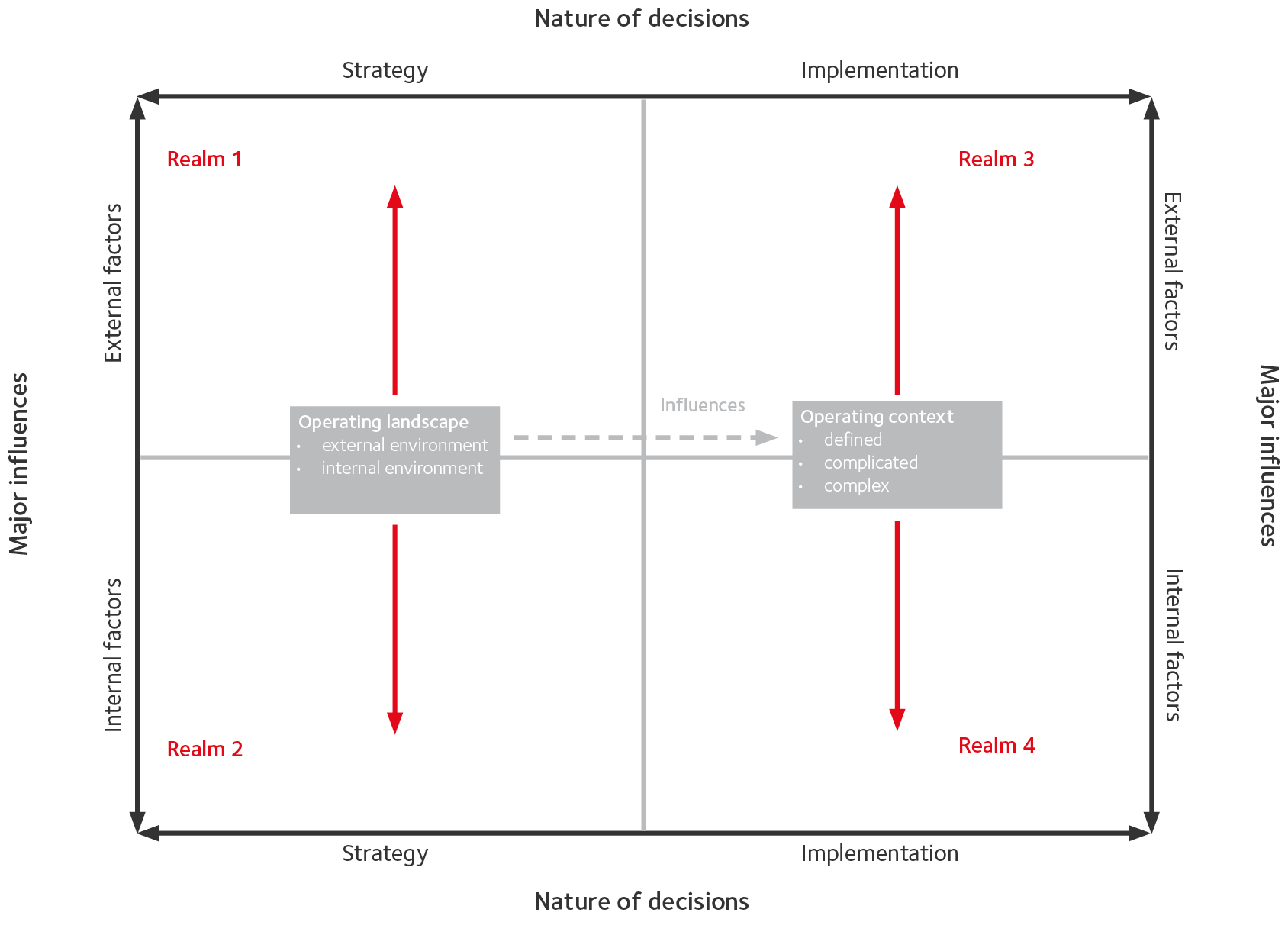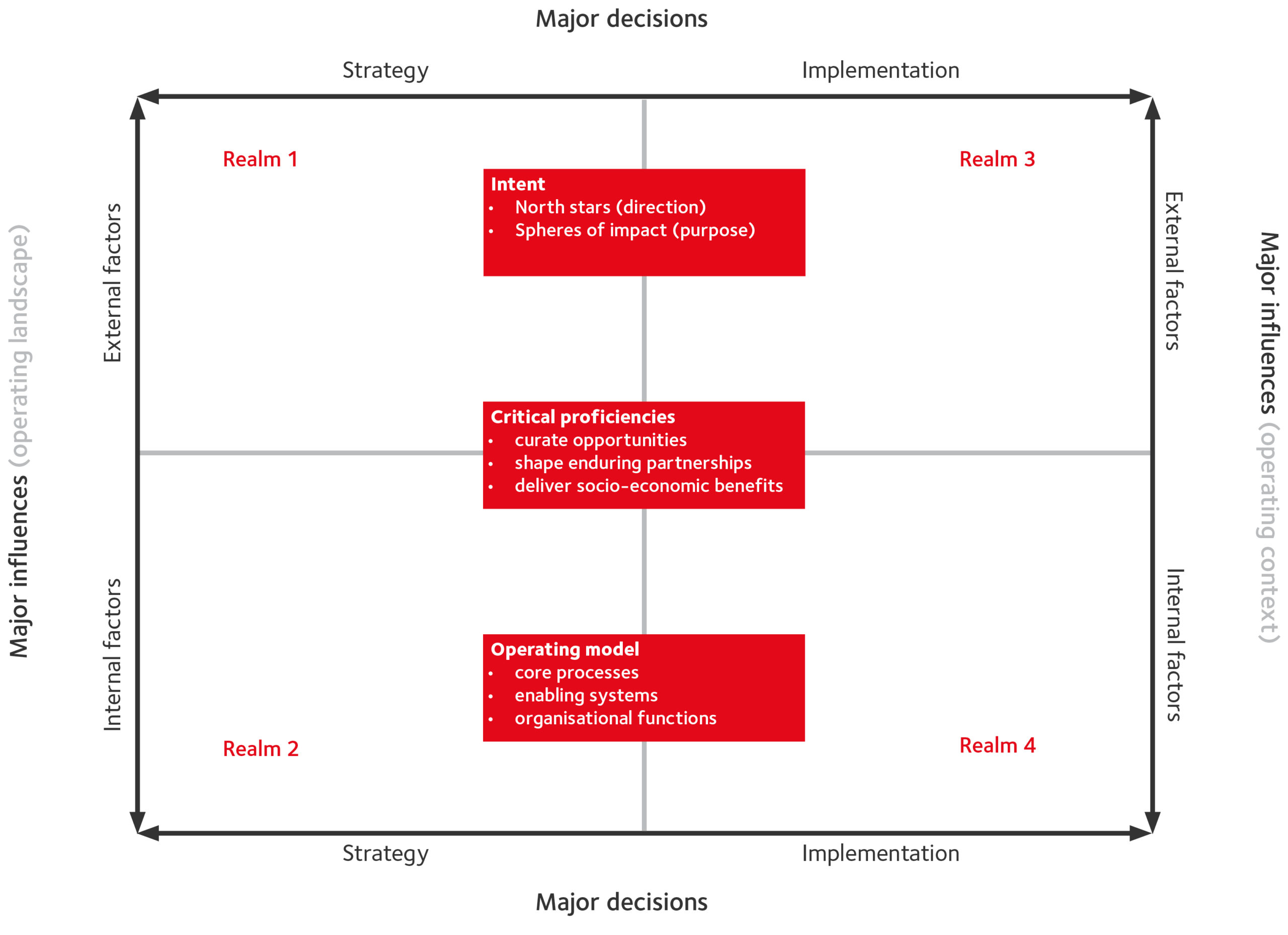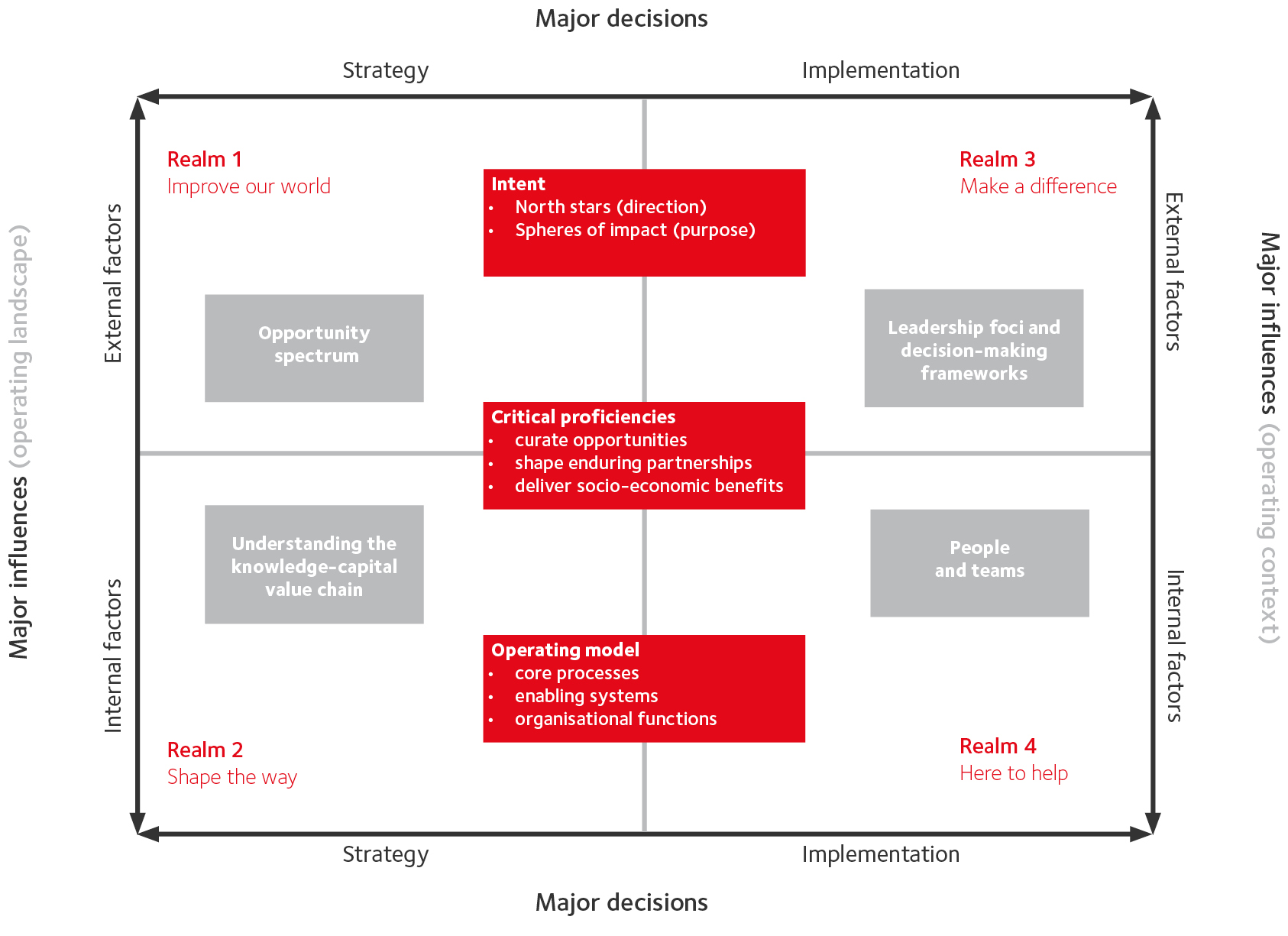This is Section 12 of the series on the topic of deriving impact from universities in the 21st century, authored by Nicholas Mathiou, Director of Griffith Enterprise.

“Our values decide our character. Our character decides our value.”
– James Kerr, Legacy: What the All Blacks can teach us about business of life (2020)
12. Implementation model – values and behaviours
Introduction
At the heart of this series sits a question about what sets a university apart when it comes to deriving impact? It is a question which takes to its feet in the face of uncertainty, at a time when direction and purpose can be blurred and equivocal. In assembling – across four sections of this series – a template for an implementation model, we attempt to respond by framing how a university acts as an organisation to deliver great socio-economic benefits. At the very core of this model are people and the challenge of how to gel people together into a cohesive whole.
In a 21st century where competition escalates at a pace and resources contract at the whim of others, the challenge is accentuated if not exacerbated at times. But it is a challenge which must be taken on. To do so, as with any organisation, people must be empowered to do extraordinary things. For optimal results where the goal is societal benefit, all efforts in this respect must be aligned and the values which guide behaviours play a binding role.
In this section, therefore, we recognise the need for a university to build values and associate behaviour so that its people have a clear understanding of what is required of them. Cognisant of the decision-making properties that all members of staff possess, and their capacity to act on these properties, we embark on a layer by layer process to create a framework which can be used to embed and instil true values within and across an organisation that align with the goal to benefit society. While this section leans heavily on the work of previous sections in the series, it starts with a new and brief discussion of the concept of values.
Values and behaviours
Values help an organisation define ‘who we are’, ‘who we aspire to be’ and ‘how we work together’. Where they are true, they are idiosyncratic and peculiar to that organisation. They must represent choices of people which relate inherently to organisational direction. Values, therefore, are the guiding principles that shape actions that inform and fulfil organisational direction. They can be utilised by universities to frame the organisational policies which lay out the obligations of their members and to set expectations for the behaviours of all organisational members. When they are effective, values guide behaviours and help people make the right choices and decisions.
Values should not be confused with virtues or beliefs. It is relatively easy to build a consensus around broad virtues such as ‘excellence’, ‘respect’, ‘integrity’ and ‘communication’[1]. These can be applied to any organisation in the world but it is not unusual for them to be meaningless and pretence and amount to little more than noisy lip service. We must ask how values become more than lip service? How can values become meaningful, embedded, and aligned with deriving impact from universities? A response to this inquiry is advanced through the construction of a framework across four stages, and starts with an examination of the factors that influence university decision-making.
Stage 1: decisions and influences
A university must know and understand the operating landscape in which it is located, and how this environment influences the process of decision-making. Therefore, decisions about strategy and its implementation must be made in the context of highly influential external and internal factors. Mapping the natures of these decisions and the influences that shape them is an important starting point for the development of a framework for organisational values and behaviours. This initial stage of the mapping process is essentially twofold and our focus falls first on strategic decision-making.
Strategic decisions
For an organisation such as a university, strategic decisions involve answering questions such as: (a) whom do we serve? (b) what is our ambition, value and purpose? (c) what distinguishes us? (d) what market segments should we target? (e) what paths-to-markets should we pursue? (f) what competitive value-propositions should we offer? (g) what underlying assets do we need to make our offerings better than alternatives?
It is clear that in responding to these questions, strategic decision-making is influenced by both external environments and internal environments (collectively ‘operating landscape’). External factors that can influence strategic decisions include demographic trends, size of markets and their growth rates, competition, industries structures, economic conditions, and geo-political climate. Internal factors that can influence strategic decisions include the natures of a university’s underlying assets. Typically, these include knowledge (e.g. education programs, research results and publications), research capabilities (e.g. expertise, specialist equipment, facilities and research methodology), innovations (e.g. technologies and associated rights), financial position, organisational functions, people and relationships.
Implementation decisions
Implementation decisions require answers to questions such as: (a) what are the facts and how should we respond? (b) what are the options and which should we choose? (c) how do we garner the knowledge we need to make decisions, and what are our next critical steps? (d) what is required, and who should we involve?
These decisions need to be aligned with strategic decisions which, as we have seen, are heavily influenced by the operating landscapes (external and internal environments) that universities must traverse. These can be broad and varied and their numerous states of flux may be categorised at different moments in terms of three ‘operating contexts’, namely (i) defined, (ii) complicated and (iii) complex operating contexts. The first of these is characterised by certainty and stasis; the second by changeable, active environments; and the third by uncertainty and dynamism. The context in which a university operates at any given moment has a major bearing on the nature of information gathering, and the required approaches to decision-making and implementation.
We can now set in place the first layer of a framework to shape and inform organisational values and behaviours.
The matrix presented below establishes four key ‘realms’, and demonstrates how a university’s operating landscape – spanning realms 1 and 2 – influences strategic decisions; and how operating context, as a function of operating landscape, influences implementation decisions and spans realms 3 and 4.

Stage 2: constants
From the dynamism at play in Stage 1, we turn to the factors that anchor all decision-making for universities seeking to derive impact (and subsequently to the approaches used to source and frame the information required and related actions).
Earlier sections of this series have canvassed three critical components to deriving impact from universities. Intent – a combination of direction and purpose – is predominantly influenced by external factors. Critical proficiencies, those matters at which a university must excel to derive socio-economic impact, are at the heart of all matters. An operating model, the processes, systems and organisational functions required to deliver value to stakeholders, is heavily influenced by internal factors. These three key constants are inherently interrelated and central to galvanising shared action. Each is an important, standalone concept which has been explicated in earlier sections of this series. In the context of this discussion of values and behaviours, they can also be seen as university bellwethers which span both strategic decisions and implementation decisions.
Returning to the matrix laid out at the end of Stage 1, these ‘constants’ can now be mapped as depicted in the diagram below.

Stage 3: approaches
Each university will take a different approach to a major strategic decision or significant implementation decision. In particular, four key approaches – each also canvassed in earlier sections – underpin this process. They are (i) discerning the opportunity spectrum (section 5); (ii) understanding knowledge-capital chain (section 4); (iii) determining the required leadership foci and decision-making frameworks (section 10); and (iv) arranging people and teams (section 11). The first two apply to strategic decisions, and the latter pair to implementation decisions, as will be outlined here.
It is incumbent upon a university to discern the opportunity spectrum before it and to make strategic decisions based on this undertaking. Importantly, such undertakings must be constant and continual, enabling the university to make strategic decisions which consistently position it competitively. This approach is heavily influenced by external factors including market attractiveness and competition, but also undertaken with reference to a university’s underlying assets.
Strategic decisions are also enabled and obligated by an understanding of the ‘knowledge-capital value chain’ and the natures of underlying assets, differing markets and paths-to-markets, and associated delivery mechanisms. Specifically, these are the strategic decisions necessary in order to ascertain needs, build matching value propositions and arrange flexible, fit-for-purpose approaches to maximise impact. This approach is heavily influenced by internal factors, but also made with reference to a university’s opportunity spectrum.
Understanding the context in which it operates allows a university to inform its leadership and decision-making process, and can be the source of major competitive advantage at times of uncertainty in a world beset by rapid change. The appropriate leadership foci and decision-making frameworks, and related decisions on implementation, are dependent on the operating context at play and heavily influenced by external factors.
The second approach guiding implementation decisions recognises both the distinction between ‘position’ (a function of staff) and ‘role’ (required task) and the importance of this distinction when allocating staff to different key actions (or ‘core processes’) required to deliver socio-economic benefits. These implementation decisions are heavily influenced by internal factors, but undertaken in light of the required leadership foci and decision-making frameworks.
Returning now to the framework for values and behaviours under construction, this third layer of associated approaches is now mapped onto the matrix, along with the natures of the required decisions and key influences (Stage 1), and the constant factors that anchor all decision-making (Stage 2).
Four major ‘realms’ are revealed as a result of stages 1-3. These are depicted in the diagram below and will be discussed briefly in the next segment.

Stage 4: crafting meaningful values
The framework we have developed can be used as an effective tool, showing how and why values guide choice of behaviour and potential alignments between values and activities. Key to this are the four distinct realms which have emerged within the framework as each layer has been applied in stages 1-3. A thematic function has been attached to each realm as follows:
- Realm 1: ‘Improve our world’ (combining intent, opportunity spectrum and critical proficiencies);
- Realm 2: ‘Shape the way’ (combining operating model, understanding the knowledge-capital value chain and critical proficiencies);
- Realm 3: ‘Make a difference’ (combining intent, leadership foci and decision making-frameworks and critical proficiencies); and
- Realm 4: ‘Here to help’ (combining operating model, people and teams and critical proficiencies).
By focusing on the key concepts in each realm, values can be aligned with suitable university activities. For example, Realm 1 focuses on why universities exist and may ultimately be utilised by universities seeking to derive impact to align values and behaviours with a focus on those in need, finding solutions to related issues and driving enduring outcomes. The process of crafting meaningful values, for each realm, requires an understanding of the specifics of the dominion, the key factors and objectives at play within that dominion, and how purposeful engagement is applied to derive values which inform decision-making. This application of purposeful engagement is an important part of this process and one which informs, maintains and activates purposeful activities within a university, the subject of the next section of the series.
Conclusion
Values and behaviours must be framed around what people need to do, not what people need to think. They must reflect the nature of the choices that have to be made (‘strategic decisions’) and the actions required to convert the choices into outcomes (‘implementation decisions’). They must take into account the factors that anchor all decision-making and the associated approaches which help frame the required information and actions. In that way, despite the continually changing operating landscapes and operating contexts that universities face, their people are more likely to focus on the important things that need to be achieved and in so doing act in ways that are more likely to derive impact.
Continually asking the following questions can help craft values and behaviours that gel people together into a cohesive whole to successfully derive impact from universities:
Question 1: What are our key strategic decisions and implementation decisions?
Question 2: What are the major factors that influence those decisions?
Question 3: What approaches are required to inform those decisions?
Questions 4: What values guide choices (and activities) that lead to desired outcomes?
Whilst values and behaviours shape actions that inform and fulfil organisational direction, there remains a further critical component of a university’s implementation model. Managing across complex organisations and differing operating contexts calls for purposeful activities that fuel tangible actions aligned with organisational direction. It also builds the organisational character required to deliver impact from universities. Therefore, it is to purposeful activities – the fourth part of the implementation model – that our series turns next.
Read the previous article from this series.

ABOUT THE AUTHOR: Nicholas Mathiou is Director of Griffith Enterprise, the innovation and enterprise office of Griffith University. He has extensive commercial experience, having established and grown innovation-based businesses and organisations. He is driven by an ambition to see great social dividends emerge through university-based innovation. He has a deep understanding of the unique challenges involved in advancing innovations within complex organisations and in dynamic environments.
[1] For those interested, these ‘virtues’ were the ‘corporate values’ of Enron (2000 annual report). As events have shown, they were not meaningful (in fact they were meaningless), nor deeply ingrained principles that shaped actions and helped people make the right choices.
Introduction image credit: photo by James Coleman on Unsplash


